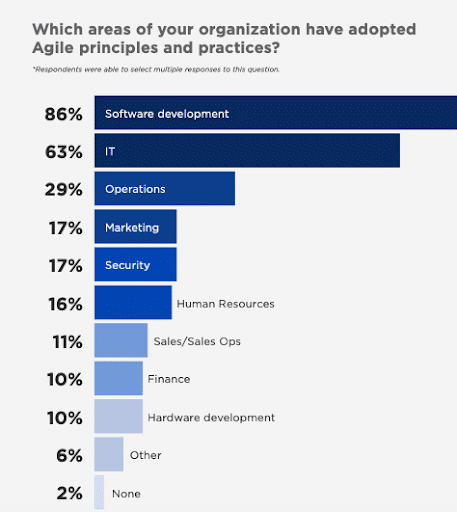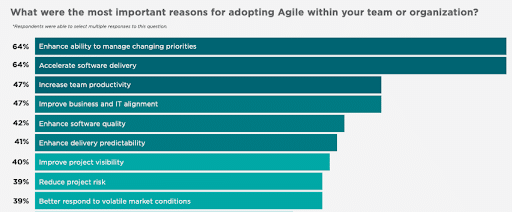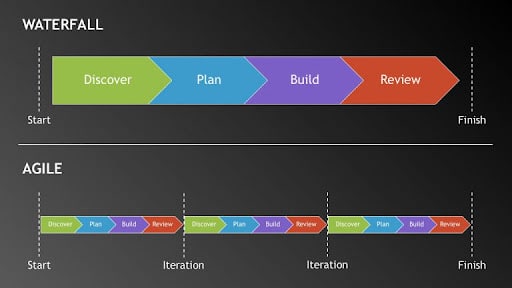It’s official: The agile development team structure is here to stay.
If that wasn’t clear already, it is now. The 15th State of Agile Report revealed that the adoption of agile methodologies by software development teams grew from 37% in 2020 to an impressive 86% in 2021.

As with so many things these days, we have COVID-19 to blame for this. Stay-at-home mandates drove an unprecedented shift toward distributed software engineering, exposing previously camouflaged inefficiencies and process bottlenecks.

Agile practices effectively reduce many such hidden costs, which explains their rapid adoption across the industry. The result? Faster delivery and increased flexibility, product quality, and team productivity.
With this in mind, let’s explore how to set up an agile software development team in 2022.
What Is an Agile Team?
Agile software teams are:
- Highly collaborative: Close collaboration and constant communication are the hallmarks of the agile approach to software development. Developers work side by side and have common goals, tasks, and milestones.
- Non-hierarchical: An agile team has a flat hierarchy. While everyone has distinct roles and responsibilities, unnecessary management is removed and team members have the freedom to work and organize themselves independently.
- Cross-functional: Team members have varying skill sets and expertise and serve different functions within the project.
- Flexible and iterative: Agile development teams work in short delivery cycles or iterations. This enables software developers to adapt to user feedback and market changes in real time and make quick modifications when and as needed.
Agile vs. Waterfall Software Development: Know the Difference
Waterfall is the traditional approach to development.
The software development life cycle (SDLC) is broken down into phases — such as requirements gathering, analysis, design, coding, testing, and deployment — that follow sequentially. Each phase is completed only once and must be reviewed and verified before advancing to the next. The phases “flow” or “waterfall” downward in a linear fashion.
The waterfall process is plan-driven. Requirements are gathered once at the beginning. Any changes to the plan after the project kick off require a new plan and a restart.
The agile approach is incremental rather than sequential. It divides the project into a series of rapid delivery cycles, also called sprints or iterations. Each sprint can work on multiple aspects of the SDLC so that a functional application is released at the end. The development team and the customer then review the work and create a list of requirements for the next sprint, after which a new or updated software product is delivered.
It’s important to note that both methodologies have their pros and cons. Which one would be best for you depends on the scope of your project, team size limits, and your business goals.

Kanban vs. Scrum Teams
Scrum and Kanban are the two most popular agile methodologies. The team structure and principles are largely the same. What differs is the processes and team member roles.
In a Scrum environment, each team member has defined roles and responsibilities. Kanban teams adopt a more flexible approach. There are no mandatory roles, and the focus is on team member skills and current project needs rather than job titles.
4 Agile Development Team Structures to Choose From
When it comes to the best team structure for agile development, there’s no one-size-fits-all answer. Which set-up would be a better fit depends on your team’s preferences and work style, the project type, your budget and business objectives, and many other factors.
1. Generalist
Under a generalist agile team structure, all team members are well-versed in different software development phases, from coding and testing to deployment. This enables them to work on various tasks and quickly jump between roles and projects or replace their colleagues where needed. These operating models typically work well for smaller teams and projects with a more limited scope.
2. Specialist
Everyone in a specialist team structure has an area of expertise and an assigned role. Team members stick to their niche and are only responsible for tasks under that domain. Because specialists have extensive knowledge of their field, they can provide more detailed insights than generalists. That said, agile specialists still work in tandem.
This agile development team structure works best for large organizations with enough people to cover all relevant knowledge areas.
3. Hybrid
A hybrid team has both specialists and generalists. The specialists focus on building specific project components, and the generalists tie all parts together and keep the larger picture in mind. The hybrid structure offers the highest level of flexibility and is ideal for complex projects that require different perspectives and diverse input.
4. Multi-Tiered
Multi-tiered teams have several sub-teams working on specific phases of the software development process. Together, they combine to form an overall project deliverable. The multi-tiered structure is useful for breaking large projects down into more manageable parts, as well as for improving visibility and accountability.
Agile Development Team Roles
Agile team roles vary from project to project, but these are some of the most common ones:
Product Owner
Product owners represent the customer’s or business’ needs. Their job is to specify the requirements, ensure they are met throughout the project life cycle, offer guidance on must-have features, and let the team know what needs to be prioritized.
Team Lead
The team leader or lead is the most senior developer in the group. They are usually responsible for designing and leading sprints, providing technical guidance, coordinating the team, managing tasks, and monitoring workflows.
Team Members
“Team member” is a broad term that includes a wide variety of agile roles such as developers, QA consultants and testers, UX designers, DevOps, and more. Members form the core of a development team and collaborate closely to bring the project to fruition.
Stakeholders
Stakeholders are not directly involved in software development but play a key role in defining final deliverables. They communicate regularly with the product owner, team lead, and team members to offer insights that help improve the product. Anyone who has a use for the product can be a stakeholder, including end-users, sales team members, senior company executives, and investors.
Stakeholders are critical in the early stages of the SDLC when defining goals and priorities and during iteration planning.
Managing Distributed Agile Teams in a Post-Pandemic World
Most software development teams work remotely these days. To effectively manage a distributed agile team, focus on:
- Regular communication: Open, frequent, and friendly communication is essential to ensuring that everyone is on the same page.
- Daily standups: A standup is a daily meeting of the core team — usually the developers and product owners — that involves a recap of yesterday’s work, the tasks and goals for the day, and any difficulties the team may be facing.
- Delegation: Well-thought-out delegation and handovers help ensure that the right tasks are assigned to the right team members at the right time.
Are you struggling to identify the right agile team structure for your needs?
At Zartis, we specialize in building agile and remote teams and providing expert support in implementing agile methodologies. With 50+ agile teams, we’ve seen it all.
We can help you optimize your development process, identify the best agile software development team structure for your needs, recruit developers to join your existing agile teams, or assemble a brand-new team in a multi-tiered agile environment.
Get in touch to tell us about your needs.

